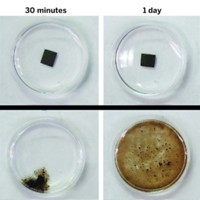Advertisement
Grab your lab coat. Let's get started
Welcome!
Welcome!
Create an account below to get 6 C&EN articles per month, receive newsletters and more - all free.
It seems this is your first time logging in online. Please enter the following information to continue.
As an ACS member you automatically get access to this site. All we need is few more details to create your reading experience.
Not you? Sign in with a different account.
Not you? Sign in with a different account.
ERROR 1
ERROR 1
ERROR 2
ERROR 2
ERROR 2
ERROR 2
ERROR 2
Password and Confirm password must match.
If you have an ACS member number, please enter it here so we can link this account to your membership. (optional)
ERROR 2
ACS values your privacy. By submitting your information, you are gaining access to C&EN and subscribing to our weekly newsletter. We use the information you provide to make your reading experience better, and we will never sell your data to third party members.
Materials
Graphene-Coated Pipette Tips Stop Water Droplets From Taking Charge
Surface Chemistry: Coating a pipette tip with graphene reduces unwanted electrical charge on droplets
by Neil Savage
June 16, 2014
The old workhorse for scientists transferring small amounts of liquid from one spot to another is the pipette. But that venerable tool has a problem: It can transfer an electrical charge to the droplets it dispenses—a charge that can be big enough to interfere with some experiments. Now, researchers from South Korea, who had previously measured the effect, have come up with a solution: coating the tip of the pipette with graphene (Langmuir 2014, DOI: 10.1021/la5018196).
The researchers first discovered the problem while they were building a microfluidic system to manipulate water droplets floating in a bath of oil, says Dong Sung Kim, a mechanical engineer at Pohang University of Science & Technology. They wanted to apply an electrical force to a stationary droplet to study how it affected the droplet’s surface. They expected the droplet to stay stationary, but it moved toward the cathode in their experimental system, indicating the droplet was positively charged. Subsequently, the team determined that the material of the tip transferred positive charges to the water passing through it. They measured the charge on a 7-µL droplet of deionized water and found it was approximately 0.2 nanocoulomb (Sci. Rep. 2013, DOI: 10.1038/srep02037). That’s about a quarter of the charge that would cause a droplet to become unstable and break apart, Kim says. That amount of charge could cause smaller droplets to stick to the pipette tip and could confound detection of charged biomolecules.
To tackle the problem, Kim and graduate student Dongwhi Choi decided to coat the pipette tip with a solution of graphene. They dissolved flakes of graphene in polydimethylsiloxane (PDMS). Then they dipped a conventional disposable plastic pipette tip into the solution several times and cured the coating by heating it to 65 °C for two hours. They picked graphene because it is hydrophobic and because it has a low zeta potential, which is a measure of the strength of the surface charges between a droplet and the material holding it. The researchers found that zeta potential is a controlling factor for how much charge is transferred to the droplet.

They measured the effect of the treated tip on droplets of a potassium chloride solution. With a conventional tip, the charge on the droplets was 0.076 nC. With a coated tip, that dropped to 0.027 nC.
Brian J. Kirby, director of the Micro/Nanofluidics Laboratory at Cornell University, is surprised that the researchers chose graphene and PDMS, which are both charged at most of the pH levels used in microfluidics. “It would be interesting to see the results if the pipettes were lined with materials well known to suppress zeta potential, such as polyacrylamide or cellulose ethers,” Kirby says.
Kim says this work proved they could decrease the amount of charge transferred to the pipette tip, and the researchers are exploring other coatings that could reduce it further. Many materials could be good candidates, “as long as they have a low zeta potential and a highly hydrophobic property,” he says.
And there may be cases where instead of eliminating the charge induced on a droplet, controlling the amount of the charge would prove useful. Kim says the team is now working on ways to do just that.





Join the conversation
Contact the reporter
Submit a Letter to the Editor for publication
Engage with us on Twitter